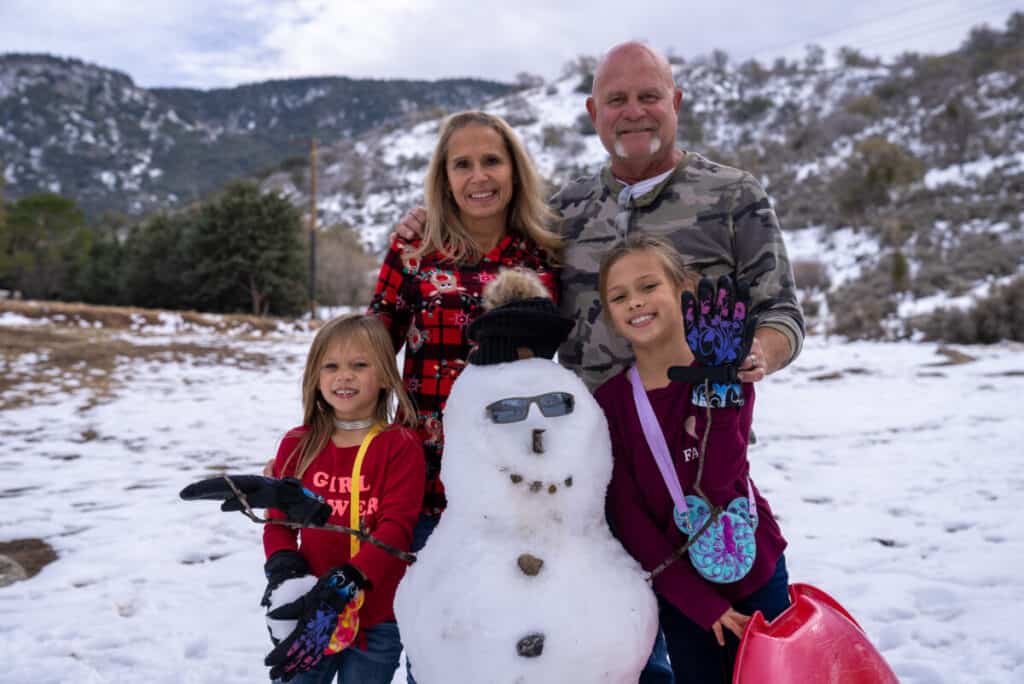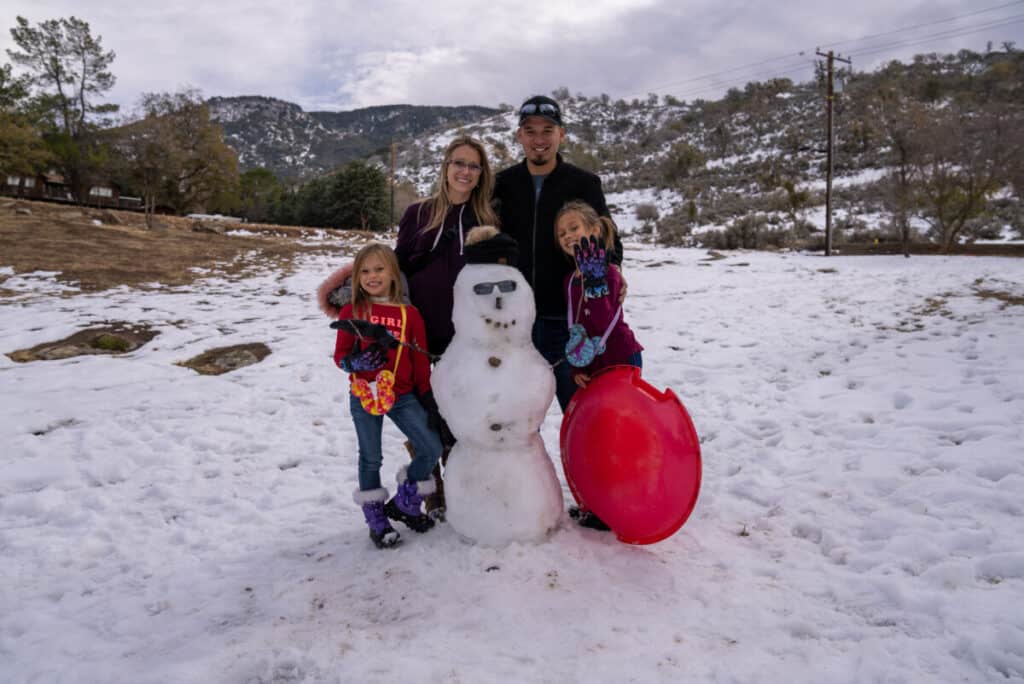It’s a fun, cold, blustery winter day out there, and you’d love to make a snowman. This is a great way to entertain the kids or even bond with other members of your family (as well as your friends). The snow you have to work with is a little light and powdery though. Will you still be able to make a snowman or is it not worth it?
It’s nearly impossible to make a snowman in powdery snow because the snow won’t stick together. To overcome the issue, you can either combine the snow with some water to make it firmer or you can wait until the next snow, which will hopefully be more conducive to building a snowman.
In this article, we’ll discuss the different types of snow and how your snowman might result. We’ll also talk about the perfect spot for building a snowman, as it has more to it than choosing an area people can see from the street. Keep reading, as you’re not going to want to miss it.
What is Powdery Snow?
You have likely heard people referring to recently fallen snow as “fresh powder.” Although this term has become commonplace for snowboarders and skiers, powdery snow is a type of snow that looks and feels like powder.
Powdery snow is created when snowflakes fall through cold, dry air, making loose and dry snow that does not stick together. This is also referred to as “dry snow.”
Dry or powdery snow is excellent for winter sports like snowboarding and snow skiing but not great for building snowmen.
On the other end, there is “wet snow.” When temperatures are a tad warmer than 32 degrees Fahrenheit, snowflakes will slightly melt around the edges and stick together to form large, heavy flakes. This is what is referred to as “wet snow.”
“Wet snow” can easily stick together and is excellent for making snowballs and our beloved snowmen. Wet snow also causes slushy messes on streets and can often turn icy.
What Are the Types of Snow?
What exactly is powdery snow? It’s one of many types of snow formed by snow crystals. These crystals include polycrystals, graupel, hoarfrost, and snowflakes. You’re probably familiar with snowflakes, but not the others. Here’s an overview of snow crystal types.
- Polycrystals: When singular ice crystals form into a snowflake, those are polycrystals.
- Graupel: Snowflakes with a round shape and a diameter of 0.1 to 0.2 inches are called graupel. These are also typically opaque, which means you can’t see through the snowflakes. The reason for this opaqueness is because graupel developsfrom cloud droplets that are very cold (well below freezing) yet still a liquid. When the droplets eventually freeze, you get graupel. Some people mistake graupel for hail, but it isn’t the same.
- Hoarfrost: Ice crystals that interlock are known as hoarfrost. This type of snow occurs when a surface has a colder air temperature than the air nearby, causing moisture to develop from vapor to a solid. If you see snow on the edges of leaves, branches, or poles, this is hoarfrost.
- Snowflakes: Then there’s the traditional snowflake. These ice crystals form in clusters or on their own and drop down from the clouds.
Depending on the snow crystal formation, you can end up with some very different types of snow, powdery snow included. Let’s talk about these types of snow now.
Perennial Snow
Have you ever seen snow that has stuck around for a long time, maybe a year? It just never seems to melt, mostly because the sun can’t get where this snow is. This type of snow has a name, and it’s perennial snow.
Seasonal Snow
The opposite of perennial snow is seasonal snow, which many parts of the country experience year in and year out. During the cold season, often winter, seasonal snow will accumulate. Once the seasons change, such as during the spring, seasonal snow will disappear until next winter.
Old Snow
Old snow and perennial snow aren’t quite the same. Snow that’s considered old is advanced, in that it’s impossible to tell when the snow crystals were deposited and how they may have changed over time. All that’s known is that a change did occur.
Neve Snow
When snow falls, melts, then freezes again and gets compacted, it’s known as neve snow. Typically granular, neve can lead to the development of glaciers in large enough quantities.
Firn Snow
Neve can also become firn, a type of snow with a round texture. It bonds well, mostly due to its age, as it’s over a year old. Firn has about a 55 percent density, which is more than 550 kilograms per cubic meter.
New Snow
New snow has very identifiable ice or snow crystals that have just settled on the surface.
Powdery Snow
When new snow lands and dries somewhat, it becomes powdery snow. The ice crystals are new and thus loose, making powdery snow simple to sift through.
Can You Make a Snowman in Powdery Snow?
As we covered in the intro, it’s not ideal to create a snowman in powdery snow. Why is that?
Well, the first part of making any snowman begins by grabbing the snow between two gloved hands and rolling it together until it’s a firm ball. Then you can begin rolling that snowball until its diameter is about a foot in size.
You already know that powdery snow is very loose. You might be able to pack it together with the force of your hands, at least in small quantities. As soon as you try to roll out that first snowball though–which serves as your snowman’s base–using powdery snow, the snowball is going to fall apart.
Even when making smaller snowballs for the torso or head of the snowman, powdery snow won’t stay packed together. A good gust of wind can also easily spread powdery snow, leaving your snowman as nothing but a loose pile of snow.

What Is the Ideal Type of Snow for Making a Snowman?
Okay, so if you shouldn’t make a snowman with powdery snow, then which type of snow is better-suited for the job? You want to avoid all new snow, as it’s typically quite loose like powdery snow.
Perennial snow can be a good choice for making a snowman if this snow isn’t slushy or filthy because it’s been around for so long. Old snow might work, but because you don’t know much about the snow crystals that comprise it, it’s hard to say.
Neve and firn are the best types of snow for your snowman. Remember, neve can become glaciers, so it’s pretty stable. Firn is known for its bonding, which is what you need when rolling snowballs.
If you’re curious whether the snow outside is workable for making a snowman, put on your snow gear, head outdoors, and try it for yourself. If the snow willingly makes a ball shape when you grab it and pack it in your hands, then you can use it for your snowman. Besides snow with a powdery texture, avoid snow that’s fluffy too. It will similarly fall apart.
Can You Make Powdery Snow Firmer?
You wish you had more packed snow for making a snowman, but right now, the snow outside is definitely powdery. Is there anything you can do to firm it up?
Sure! You have two options here. One is you can take some water, pour it over the powdery snow, and then begin to make your snowman. This may tighten up your snow so it’s firmer, but the results are not guaranteed.
If you are going to try this method, make sure your winter gloves are waterproof or you’ll end up with very cold hands.
Your other option is to wait. Since powdery snow is relatively new (but not as fresh as new snow), it hasn’t had a chance to solidify too much. With some patience, it’s possible the snow may become firmer. Then again, the ideal snow for making a snowman is moist as well as firm, and powdery snow is often dry. This too may change with time.
If your weather forecast has many cold days ahead, then the snow on your lawn now isn’t likely to go anywhere for a while. Wait it out and maybe you can make a snowman in a few days.
Steps to Building a Snowman with Powdery Snow
- Outline your snowman design
- Collect buckets of snow and mix in water to create slush. It’s important to strike the right balance with the water – not too much, not too little, but erring on the side of more water is preferable. Achieving the perfect consistency may require some trial and error.
- Instead of rolling a small snowball in the snow to make the balls, you’re going to have to build your snow handful of slush by handful of slush molding the snowman’s body.
Building a snowman with this method is going to take longer, but if you’re patient you’ll be able to have yourself a nice looking snowman.
Further Reading: How to make powdery snow sticky
Where Is the Ideal Spot to Make Your Snowman?
When you make your snowman with the kids or a couple of buddies, where do you begin the project? Probably in the center of your lawn, right? After all, half the point of making a snowman is so people can see it from across the street or in their cars and honk in appreciation as they drive by.
Yet depending on where you put your snowman, you could be accidentally setting it up for failure.
For example, do you build your snowman on the cement walkway or asphalt driveway? Both locations are warmer than your lawn, which is sure to melt your snowman quickly. Also, someone can easily knock the snowman over when backing the car out of the garage once your fun snow day is over.
Does your lawn have a slope? That’s a no-go as well. A slope is uneven terrain, which doesn’t make your snowman very stable. Most snowstorms bring with them heavy winds, and since your snowman is on a curve or angle, it’s very likely to fall over before the day is out.
Instead, you want to look for a flat, even part of your lawn and build there. It doesn’t necessarily have to be front dead and center, but secure. Outside of that, you also want a shady spot for your snowman if at all possible. Even if you give him (or her!) a top hat like Frosty the Snowman, that’s not enough to protect the rest of your snow-friend from the blaring rays of the sun. Your snowman will stick around longer if you put ‘em out of direct light.
Visit our Winter/Snow Page for More Great Content!
Final Thoughts
Powdery snow is relatively new and pretty dry. It also doesn’t pack firmly at all, making it a poor choice when you want to make a snowman. You can try adding water to powdery snow to give it more firmness or wait for a better snowfall that’s better for packing and rolling snow. Best of luck!

Want The Best Snowman On The Block?
You’ve just spent hours crafting the perfect snowman. Now the time has to come to give him or her some personality through decorations. Sure, you could rummage around your home and see what’s there or even buy a snowman decorating kit, but you want to go against the grain. What cool snowman accessories can you get your hands on?
You worked really, really hard on your snowman, putting hours into his perfect sculpting, assembly, and decoration. Sure, you took lots of pictures, and pictures are worth a thousand words, but you don’t just want a picture. You want your snowman to stick around for as long as possible without melting. Is there any way to hold onto your snow friend for longer?
